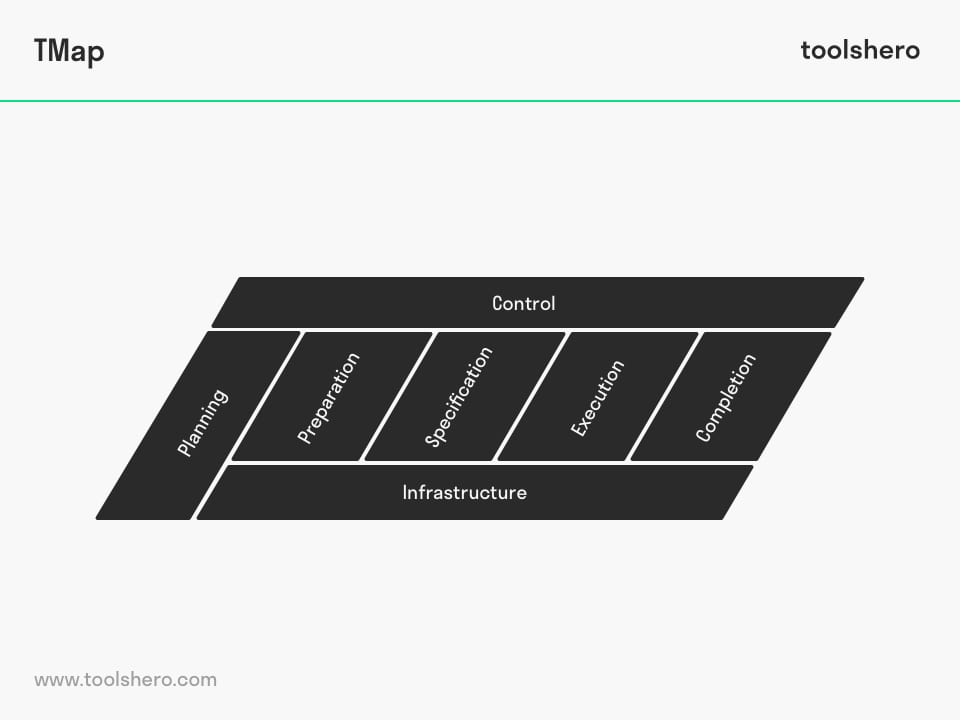TMap (Test Management Approach)

TMap: this article provides a practical explanation of the TMap / Test Management approach. Highlights include what a TMap is, what its essential components are and why it is a Business Driven Test Management (BDTM) approach. Finally, we cover the TMap phases and the advantages of using this test approach, concluded with a brief summary. Enjoy reading!
What is the TMap / Test Management approach?
TMAP stands for Test Management approach. It is a leading approach for testing software. This structured Test Management approach could help in delivering complex and high-quality software more quickly, allowing organisations to save time and money. The method offers a toolbox for setting and conducting tests in combination with manuals and instructions. The approach of structured testing consists of four essential components. These are discussed in further detail in this article.
The time-tested method is based on Sogeti research and user experience. The flexible approach makes it an interesting choice for a wide range of organisations and industries. Many large organisations use this method as standard test approach.
The first version of the software test approach was developed by Dutchmen Martin Pol, Ruud Teunissen, and Erik van Veenendaal in 1995. At the end of 2006, a new version followed, named TMap NEXT. In 2020 the latest TMap book “Quality for DevOps teams” was published. The brand name Test Management Approach is owned by the Dutch division of Sogeti, part of Capgemini.
TMap should not be confused with thematic maps for mapping spatial data.
Essential Components TMap
Test Management Approach is an extensive and comprehensive process. The basis for this approach to testing software can be explained by means of the four basic components of the approach.
The first essential component is directly related to the fact that business cases are becoming increasingly important, and are used increasingly often in organisations. This business driven Test Management approach is therefore seen as leading for the second component: the structured TMap test process.
This process shows a test process’s life cycle. In this process, various aspects in the field of IT infrastructure, technology and organisational resources must be set up and managed to correctly complete the process. For this purpose, Test Management Approach offers a lot of practical and applicable information in the form of examples, checklists and procedures.
This toolbox forms the third component. Building and setting up a Test Management Approach process can be done for a new system or an existing system. Parts mights also be outsourced. The full package is an adaptive test method, with toolbox, structured and based on business cases.
Business Driven Test Management (BDTM) Approach
Testing is often carried out by means of checklists and procedures. Carrying out a good test isn’t easy, however.
To make the test useful, the tests must be aimed at testing specific parts or properties that are believed to function insufficiently later in the production or another situation. This means that the possible functioning and future of the business unit must already be considered before the test.
Because this test and these choices are based on aspects such as result, risks, time and costs, this approach is also referred to as business driven.
Structured Process
To test is to establish the difference between current properties and required properties. It is fundamentally different from supervision, even though these two are linked.
An important aspect is setting the standard. This aspect recurs in nearly all forms of testing. The testing method differs. Sometimes, only a sample is taken. Other times, risk analyses are conducted to discover future mistakes and anticipate these. The test management approach is a complete test approach, including procedures and techniques.
You can find a complete description of the Tmap process further below in this article.
Complete Toolbox
As indicated, the approach comes with tools and procedures. The toolbox helps the user with:
- Test diagnoses
- Defect management
- Selecting or drawing up and maintaining statistics and variables
- Product risk analysis
- Product evaluation
Adaptive test methods
One of the advantages TMap offers compared to other test methods is that it can be adapted to environments in which other methods are used, such as Agile and Scrum.
TMap Phases
The complete TMap NEXT test approach consists of several phases. Two extra phases have been added to this, namely infrastructure and management. These are not crucial for the testing itself, but rather benefit quality management. TMap consists of the following phases:

Figure 1 – The Phases of the Test Management Approach (TMap)
1. Planning
In the first phase, the complete test strategy is determined based on a risk analysis. This gives rise to an approach that is included in the test plan. The budget and procedures are added to this later. The complete test plan and approach are subsequently presented to the stakeholders. When they support the plan, the client approves of the plan.
2. Management
Often, it’s not possible to actually carry out all components of the test plan. Therefore, all components are managed during the process. In the management phase, a continuous phase, the activities from the plan are managed, guarded and, if necessary, adjusted. The client is kept informed of the developments, the progress and quality of testing throughout the entire process.
3. Design
Efficient testing demands various adjustments. A proper test environment is important, together with the availability of test tools and good workspaces. During these phases, all activities related to these are carried out.
4. Specification
In the specification phase, test cases are created based on techniques included in the test plan. During this phase, it becomes perfectly clear what is tested and which conditions must be met.
5. Execution
During the execution phase, the test cases are executed and findings are recorded. It is often the case that problems are discovered during testing. These are documented, together with all situational properties. Eventually, it becomes clear after analysis what the quality of the test object is.
6. Completion
The test is completed during the completion phase. A detailed test report is drawn up, including all results, and various final activities are carried out to conserve data as much as possible. Finally, TMap Next offers the option to assess the executed test process.
TMap Advantages for Organisations
The structured test approach for software offers organisations various advantages:
- Extensive insight into risks through software quality
- Transparent test process
- Manageable in terms of time, costs and quality
- Warns in case of poor quality
- Short test period
- Consistency and standardisation
TMap Summarised
Test Management Approach was developed by Sogeti Nederland BV, part of Capgemini SA. The approach can be summarised in four main elements.
First, the approach is a business-driven approach. This means that the choices that are made are based on results, costs, and risks. The method comes with a structured process, from execution to management, and from planning to evaluation.
Furthermore, the company behind Test Management Approach offers a complete toolbox with tools that make testing easier for organisations. The adaptive method can be altered based on the user’s requirements and is compatible with methods such as Scrum and Agile.
Now It’s Your Turn
What do you think? Are you familiar with the explanation of TMap / Test Management approach? What do you believe are pros and cons of this approach? Is this approach used in your environment, or could it be useful? Do you have any tips or additional comments?
Share your experience and knowledge in the comments box below.
More information
- Humphrey, W. S. (1995). A discipline for software engineering. Addison-Wesley Longman Publishing Co., Inc.
- Koomen, T., Broekman, B., van der Aalst, L., & Vroon, M. (2013). TMap next: for result-driven testing. Uitgeverij kleine Uil.
- Pinkster, I., Van De Burgt, B., Janssen, D., & van Veenendaal, E. (2006). Successful test management: an integral approach. Springer Science & Business Media.
- van der Aalst, L., Roodenrijs, E., Vink, J., & Baarda, R. (2013). TMap NEXT: business driven test management. Uitgeverij kleine Uil.
How to cite this article:
Janse, B. (2019). TMap (Test Management Approach). Retrieved [insert date] from Toolshero: https://www.toolshero.com/information-technology/tmap/
Published on: 07/25/2019 | Last update: 08/15/2023
Add a link to this page on your website:
<a href=”https://www.toolshero.com/information-technology/tmap/”>Toolshero: TMap (Test Management Approach)</a>












